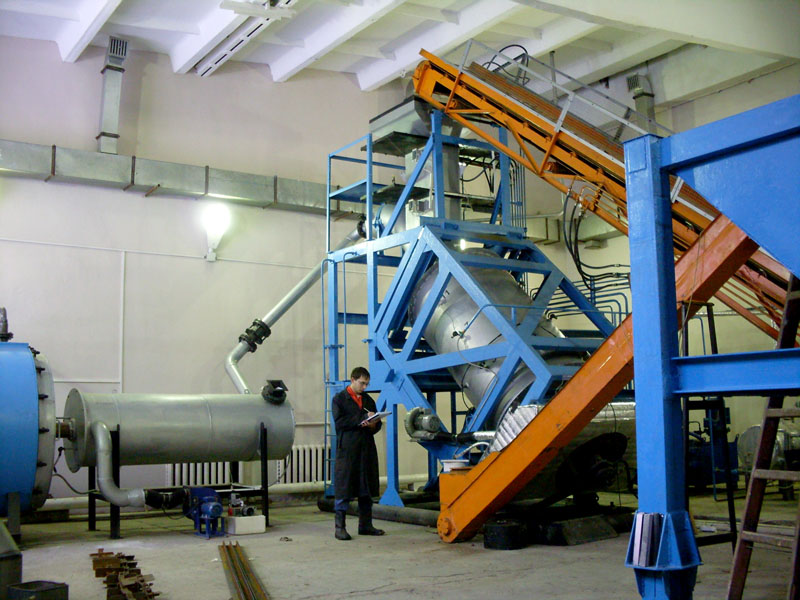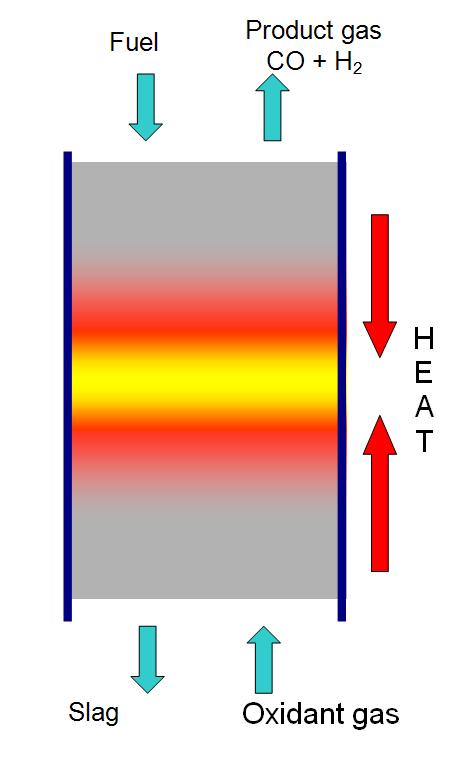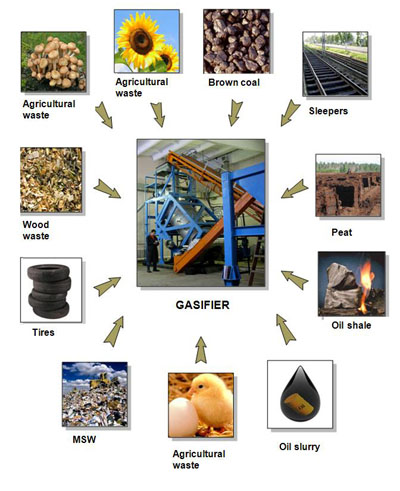Gasifier for Solid Fuels
Presently, due to the rising prices of gas and electricity, interest has been renewed in issues of heat and / or electricity generation based on low-calorie local fuels such as coal, peat, etc. and also on combining energy generation with waste disposal (timber and forest wastes, agricultural waste, worn-out tires, household waste, oil sludge, etc.).
Specificity of the different existing methods of solid fuels disposal.
Today, the production of such equipment have been involved in many countries, to solve this task.
Bark incineration boilers have been established at a wood processing factories. In practice, they require complex preparation of fuel.
Wood chips and bark should be dried and chopped because of this conditions production makes frequent stops during working.
The disadvantages of such boilers:
- Careful preparation of fuel, milling to
- Low efficiency,
- Low environmental performances, as this is a process of direct combustion of fuel, there ere high amount of dust, soot, dioxins,
NOx.The cost of such systems include boiler and flue gas purification is highly enough.
A serious drawback of the existing gasifiсtors is fuel chocking-up and as a result, uneven combustion, which can lead to burnout of gasificator-body. Сomplex installations are made to turn up fuel, but they are not failsafe and longevity.
IPCP Gasification Technology (The Institute of Problems of Chemical Physics of the Russian Academy of Sciences).
 The first experimental design gas shaft-kiln type gasifier generator
using the technology of the Institute of Problems of Chemical Physics, Russian Academy of Sciences (Chernogolovka, Moscow reg.)
Was launched in
The first experimental design gas shaft-kiln type gasifier generator
using the technology of the Institute of Problems of Chemical Physics, Russian Academy of Sciences (Chernogolovka, Moscow reg.)
Was launched in
In 1998, experimental industrial shaft type gas generator for disposal of MSW (municipal solid waste) was as built and tested in Lappeenranta, Finland.
In 2004, a similar gasifier was manufactured and delivered to Russia,
installed at MMPP "Salut", Moscow and tested on wood waste
These plants confirmed viability and high environmental performance of the IPCP technology. However, for various reasons, such equipment have not gained extensive industrial applications.o:p>

Presently, IPCP developed the technology, and t Europrofile Ltd. (Moscow) in accordance with the
general agreement of two parties have designed and built a pilot gasifier of a new design version, which has several advantages over
the previous equipments:
- The tilted rotary gasifier can stably process (gasify), various types of local fuels and wastes;
- It requires no careful preparation of fuel; pieces of fuel up to
The gasifier is designed to work with the energy-producing facilities (power plants, boilers) to provide heat and / or electricity.
In such complexes, the gasifier can work with hot-water, steam, thermal oil boiler (the latter - at a pentane power plant).
Such plants can work independently without connection to the power grid, using their own generators.
A limited (within 100 kW) external power supply is required for a short period of start-up.
Technology for gasification of solid fuel
This technology is based on the superadiabatic combustion process.
 Fuel is loaded to the top of the gasifier, where the temperature is maintained in the range 100-200 °C,
the incoming fuel being heated by the ascending flow of the product gas. Here evaporates the moisture contained in the fuel residual.
In its turn, the product gas is cooled by the incoming fuel, greatly reducing heat loss.
Fuel is loaded to the top of the gasifier, where the temperature is maintained in the range 100-200 °C,
the incoming fuel being heated by the ascending flow of the product gas. Here evaporates the moisture contained in the fuel residual.
In its turn, the product gas is cooled by the incoming fuel, greatly reducing heat loss.
In the middle of the reactor fuel gasification occurs at 1000-1200°C, and the coke formed during pyrolysis of organic matter reacts with oxygen,
water vapor and carbon dioxide producing combustible gases, carbon monoxide and hydrogen.
At the bottom of the combustion zone at a temperature of 1000-800°C residual carbon burns down and solids containing only inorganic matter (ash),
descends to the bottom of the reactor being cooled to 80 ° C by the oxidant flow.
ADVANTAGES OF SUCH EQUIPMENT:
A high chemical efficiency (transfer of the calorific value of the fuel into that of the product gas) of the process reaching up to 95%.
Owing to low linear velocity of the gas flow in the reactor, this technology secures a very low entrainment of dust particles with the product-gas;
this provides a strong reduction of the dust emissions compared to a direct combustion boiler.
With the use of a special burner for burning the product gas, NOx emissions are much lower than those from a solid-fuel-fired boiler.
The ash discharged from the reactor does not contain unburned carbon and has a low temperature,
which facilitates its handling. It can be used, e.g., in road construction.
Burning in two stages secures a dramatical reduction of dioxins in the flue gas, as:
- Suppressed is formation of aromatics (precursors of dioxins) in the combustion products;
- Gasification provides a low concentration of dust particles (catalysts of dioxin formation).
A distinctive feature of the solid
fuel gasifier is that the product gas leaves the reactor at low
temperature. Thus, the heat released during combustion does not escape
the reactor but remains in the combustion zone and is used to produce
hydrogen from water vapor reacting with the fuel in the combustion zone.
The composition of the product gas varies depending on a type of gasified fuel. For example, when bark and sawdust are gasified,
the pyrolysis tars in the product gas bear a substantial part of gas caloricity. The gasification of coal (high-ash anthracite) yields virtually no pyrolysis tars.
To protect the boiler from deposition of tars on the heating surfaces a special burner for gases containing tars has been developed.
Main characteristics of the gasifier:
- Throughput of gasified fuel (wood waste) - 2400 kg / h.
- Fuel moisture - up to 30%.
- Termal power on the burner depends on fuel caloricity. For example, for wood waste - up to 9 MW.
- Temperature of the product gas leaving the gas generator - within 100°C.
- Output of fuel gas from the gasifier - 5100 kg / h.
- Overall Dimensions (including accessories) (L x W x H) - 11300 mm x 14100mm x 7200 mm.
